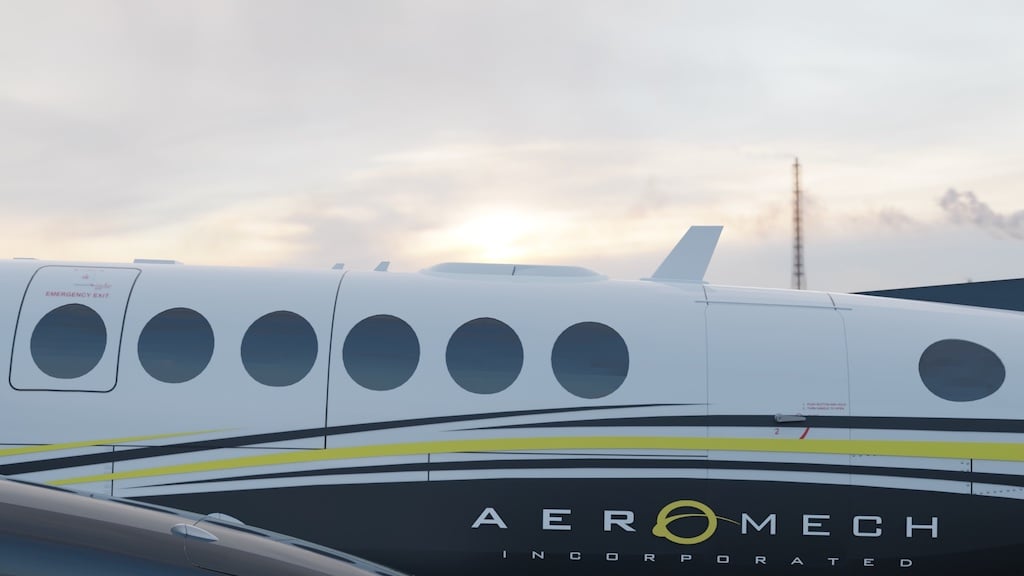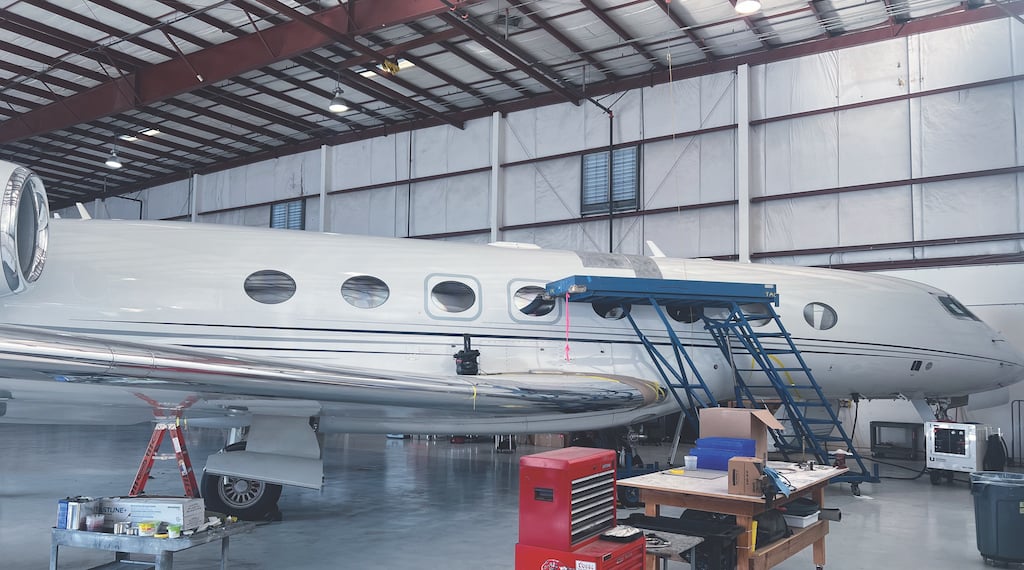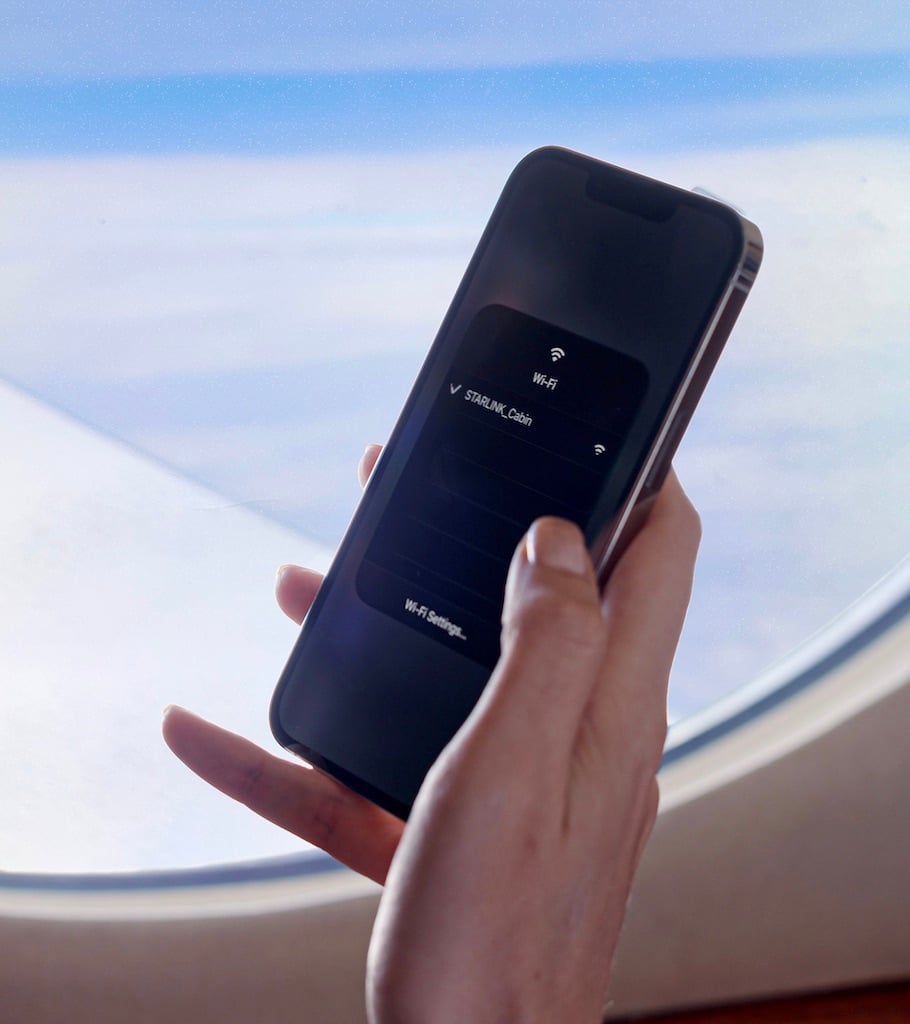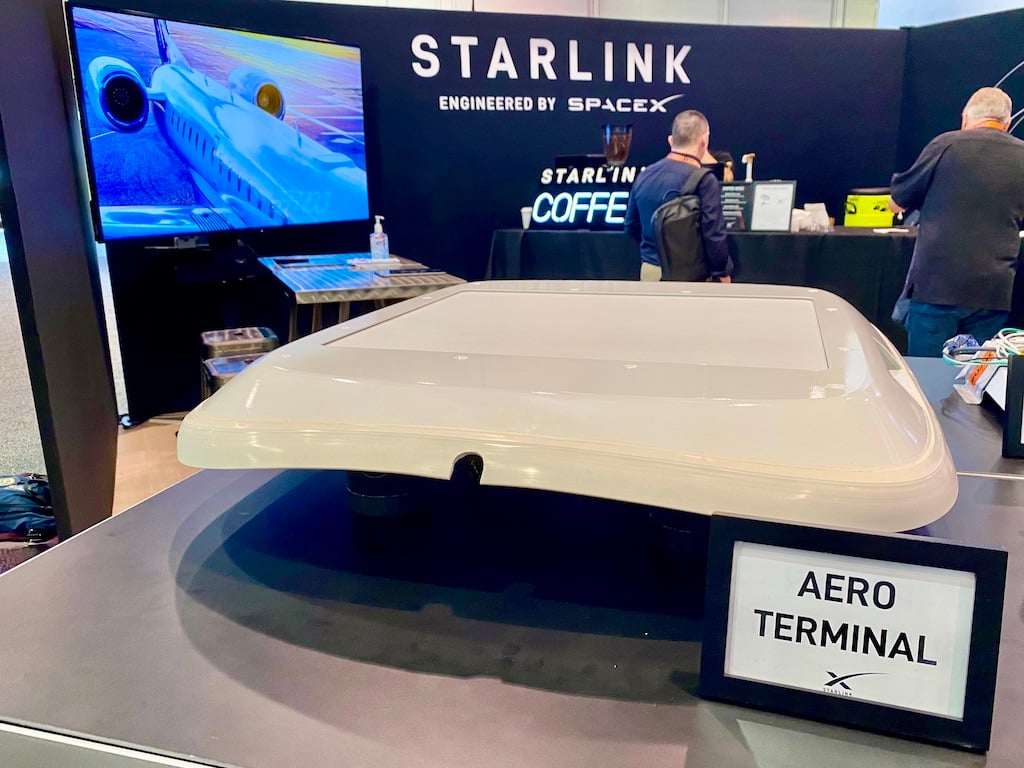
AeroMech has developed supplemental type certificates to install Starlink's Aero Terminal (flat antenna, top of fuselage) on Beech King Air 200/300-series turboprops.
Less than two years ago, SpaceX’s Starlink satellite communications (satcom) system for business aircraft was little more than a nascent science project in SpaceX’s Redmond, Washington, laboratory. It has now become the hottest new cabin connectivity technology in more than 20 years, providing a standard of internet performance only available on the ground just 24 months ago.
It is not just the 200+ Mbps download and the 20+ Mbps upload speeds, it is Starlink’s 20-30 millsec.—almost imperceptible—latency delays made possible by using a network of KU-band satcoms residing in low earth orbit (LEO) about 300 nm (345 mi.) above sea level.
Contrast that with KU- and KA-band geostationary (GEO) satcom satellites that are parked more than 19,000 nm above earth. The highest connection speeds seldom exceed 20 Mbps. Just as importantly, there is no beating the laws of physics with respect to latency. The GEO space vehicles are 63 times farther away than Starlink’s LEO satellites. That results in 500 millsec. to 550 millsec. (half-second-plus) latencies, significantly degrading user experience when using interactive programs, such as video conferencing.
Satcom Competition

Starlink may be captivating the market at present, but it faces direct competition from Gogo Business Aviation, which is developing its own satcom system—Gogo Galileo—that will operate on the Eutelsat OneWeb network of KU-band LEO satellites positioned 1,200 km (746 mi.) above the Earth. Gogo has said that it plans to compete with Starlink on price and will offer Galileo as both a standalone system and as a hybrid connectivity solution with its new 5G air-to-ground (ATG) network. It expects Galileo will enter service late this year.
Performance advantages aside, Starlink’s lower installation cost, compared to current KU- and KA-band satcom systems, also makes it attractive. The basic 48-lb. avionics kit from SpaceX—including Aero Terminal phased array, electronically steered antenna, 500-watt power supply and a wireless access point, also known as the router—costs about $150,000. Large cabin jets require one or more additional routers.
Current production systems use a 23 X 24-in. flat antenna that is attached to the top of the fuselage with a conformal adapter and fairing. Installers claim that an associated drag increase is almost negligible on large cabin aircraft and there is little increase in interior sound levels due to aerodynamic interference.
With installation and supplemental type certificate (STC), total cost ranges from about $225,000 for a Beech King Air or light jet up to about $350,000 to $400,000 for large-cabin aircraft, if the aircraft interior must be removed and reinstalled. That is roughly half the cost of installing a KA-band satcom system. If the interior has already been removed for a major airframe inspection, the incremental cost of installing Starlink is considerably lower. Installed weight ranges from 65 lb. to 85 lb., depending upon the aircraft.
The number of business aircraft for which Starlink STCs have been issued is growing rapidly. Starlink contracted with Aerospace Design & Compliance of New Castle, Delaware, to complete an STC for Embraer 135 aircraft on behalf of charter carrier JSX, essentially providing a beta test program to perfect the system. The Delaware company now is developing an STC for EMB-135BJ jets, marketed as the Legacy 600 and 650, according to Dan Utterson, the firm’s director of engineering. Capitalizing on that experience, Starlink broadened the scope of its aviation activities.
King Air Installations

SpaceX authorized AeroMech, an FAA Organization Designation Authorization installer based in Everett, Washington, to develop STCs for Starlink on 16 Beech King Air 200- and 300-series models, says COO Anthony Weiderkehr. AeroMech subsidiary AMI Aviation Services now installs the system at its Orlando Sanford International Airport (KSFB) and Smyrna Airport (KMQY) MRO facilities or via remote “go teams.” AeroMech/AMI will also provide STC and Parts Manufacturer Approval installation kits to other Starlink installers.
Developing the King Air-series STC took 16 months and was slowed by SpaceX’s desire to make improvements to some of its Starlink line replaceable units (LRU), Weiderkehr says. He expects future STCs to be completed in six months or fewer.
“This first one took quite a while, and part of the reason was because during the STC process, [SpaceX] found improvements they wanted to make to some of the LRUs—the Starlink equipment—to have a product they could certify long-term on a lot of different aircraft,” Weiderkehr relates. “They wanted to kind of pause the effort and make an optimized, aviation-grade version of those units. We actually ended up DO-160 [hardware] testing that under our STC.”
Cleveland-based Nextant Aerospace, a subsidiary of Directional Aviation, pursued multiple STCs for sister company Flexjet because Kenn Ricci, the principal at parent company Directional Aviation, says his customers were frustrated with poor inflight connectivity provided by older satcom and ATG service providers.
Large Cabin Jets

Nextant now offers Starlink STCs and installation kits for the Bombardier Global Express, Global XRS and Global 6000, plus the Gulfstream G450, G550 and G650. The firm is developing STCs for the Bombardier Challenger 300/350/3500 and Global 7500, the Embraer Phenom 300 and the Gulfstream G-IV/G-IVSP.
Notably, Gulfstream is not endorsing Nextant’s STCs for its current production large-cabin business jets. Sources close to Gulfstream tell BCA the manufacturer is developing its own proprietary Starlink satcom solutions.
Using STCs developed by AeroMech, Nextant and Aerospace Design & Compliance, SpaceX has authorized AeroMech/AMI, Banyan Air Service, Brunswick Aviation, Clay Lacy Aviation, Duncan Aviation, Elliott Aviation, Pro Star Aviation, Thornton Aviation and West Star Aviation, among other companies, to install Starlink systems. SpaceX started assembling a dealer network early this year and as of mid-May, listed 21 authorized Starlink dealers, a dozen aircraft types with STCs available and 20 aircraft with STCs in development.
Installation times range from 48 hr. to three or more weeks, depending on the size of the aircraft and complexity of the cabin interior that must be removed and reinstalled.
Duncan Aviation had Starlink installations in progress or scheduled at its three full-service MROs in Battle Creek, Michigan; Lincoln, Nebraska; and Provo, Utah. Satellite facilities in Houston and Fort Lauderdale, Florida, had already started or completed installations.
“Duncan is seeing a lot of demand for Starlink,” reports Justin Vena, avionics installation sales representative. “Those of us that are selling avionics upgrades on models that have STCs available are quoting it every single day now. We’re talking to people daily and writing quotes.”
Enthusiastic Reviews

Operators with whom BCA spoke, who asked to remain anonymous, say that Starlink understates connection speed. One Global XRS chief pilot, for example, says he has documented 378 Mbps download and 24 Mbps upload speeds. Another reports 300 Mbps download speeds on his company’s G650 jets.
Another pilot who flies Global XRS and 6000 jets says: “It’s incredible. Duncan Aviation, Houston, did our installs, [which were] five-star jobs. Worked right out of the box. No comparison with KA-band. Starlink is less than half the price.”
A third pilot says: “I’m currently flying a G650 with the system, and all the way across the pond [North Atlantic], it was as good as being in my living room. It’s head and shoulders above anything else I’ve experienced in an aircraft.”
Nextant Aerospace Senior Vice President of Maintenance Jay Heublein says he has documented company flights during which 38 devices were logged onto Starlink, including several devices used to stream 4K movies. Starlink also supports VoIP (Voice over Internet Protocol) phone calls.
In light of Starlink’s impressive performance, SpaceX initially planned to offer the service for $40,000 per month to early adopters. However, customers balked at such steep prices. SpaceX’s Starlink division then reduced prices to $15,000 to $25,000 per month, depending on the data plan. But such prices were still too close to what business aircraft operators were paying for KU- and KA-band satcom.
The latest pricing has been slashed to $2,000 per month for 20 GB, plus $100 per GB for additional data and $10,000 for unlimited global data. This positions Starlink as a direct price competitor to ATG connectivity providers.
Starlink prices “are budget dust for large-cabin [business aircraft] operators,” a G650 pilot says.
SpaceX engineers have provisioned Starlink for plenty of growth potential. While the system currently uses mainly KU-, K- and KA-band for up and down links, SpaceX has secured U.S. Federal Communications Commission approval for at least 10 spectrum slices, ranging from 10.7 GHz up to 86 GHz. Its current-generation, digitally tuned phased array antennae on aircraft, satellites and gateway ground stations will support 10 GHz to 100 GHz radio communications, providing ample room to expand.
Starlink Limitations

The Starlink system, however, is not without its limitations. Some users have expressed frustration that Starlink does not tie into business aircraft cabin management systems (CMS), such as Collins Venue, Honeywell Ovation or Gulfstream’s CMS.
Users must log off their aircraft’s CMS and log in to Starlink, reversing the process if they want to return to the onboard CMS. In addition, Starlink is not certified for aviation safety services. International aviation operations still require an approved L-band satcom system, such as Iridium, for FANS1/A oceanic communications.
Starlink also blocks out most communications with end users (as well as with journalists)—a frustration for many who seek information from the company. BCA attempted to contact the company multiple times, for instance, using voice mail, text messages and email, and received no response for this report. STC developers and installers say they have experienced long communications delays and limited technical support from Starlink.
Yet Starlink remains well positioned to be one of the top satcom suppliers for business aviation going forward. The company has embraced the Garmin business model, being able to use R&D investments for a broad group of end-user market segments, with marine, recreational, home and aviation applications.
Starlink already has more than a million ground subscribers globally, more than any other satcom company. Now that the first business aircraft operators are using the system, passengers’ expectations for the price and performance of WiFi in the sky are radically changing. The fully functioning airborne office finally has become reality.






